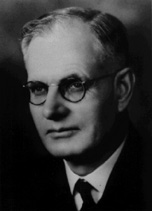JOHN CURTIN: A Brief Biography
 |
Prime Minister John Curtin (1885-1945)
led Australia through the crisis of World War II. He is the only Western
Australian Member of Parliament ever to lead his country's government.
In the years since World War II, Curtin's
appeal to America for support and protection has been seen as the beginning
of Australia's alliance with the United States. |
By standing up to Churchill, he ensured
that Australia's interests were not overridden by Britain's. Curtin's actions
have been hailed as a milestone on Australia's road to independence.
Curtin was born in the Victorian mining
town of Creswick and left school at the age of 13. He worked in a variety
of occupations before moving to Western Australia in 1917 to become the
editor of the Westralian Worker.
He first entered politics in 1928 as the
member for Fremantle in the House of Representatives, but his term was cut
short when
Labor was defeated in 1931 and he lost
his seat. However, one year after re-entering Parliament in 1934, he was
elected parliamentary leader and when the Fadden government collapsed, Curtin
become Prime Minister in October, 1941. He died in office in 1945 only six
weeks before the end of the war.
As a wartime leader, he was able to transcend
party differences by appealing for national unity and his government worked
hard to formulate a plan for a better post-war Australia.
Those closest to Curtin spoke of his constant
agonising over the crucial decisions he had to make and these undoubtedly
contributed to his final illness.
More than 20,000 people attended his funeral
service at Karrakatta Cemetery in July, 1945. Described by Fadden as "the
best and fairest" of all his politcal opponents, Curtin had been "the
right man in the right place at the right time" and deserves the accolade
as one of this country's greatest prime ministers.
Return to Lecture
list
